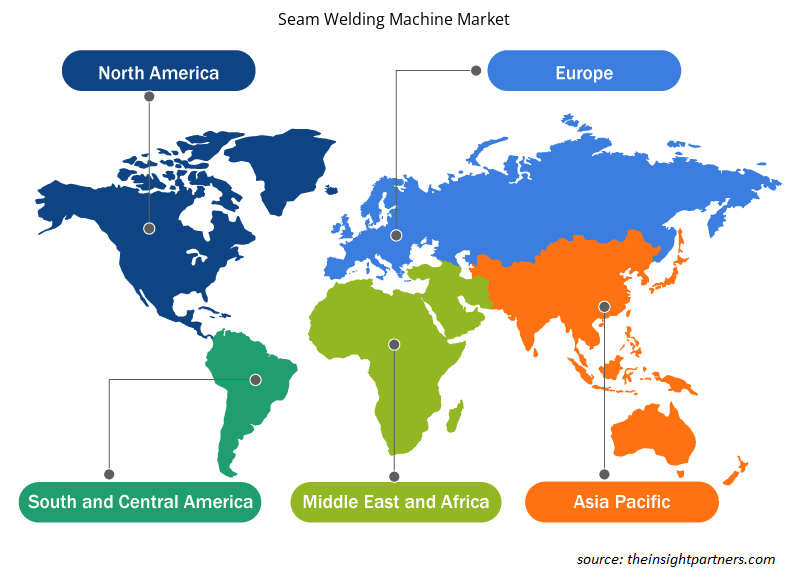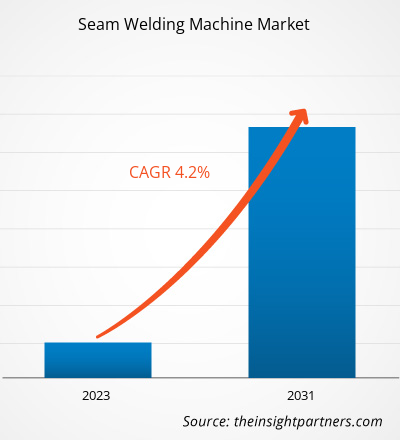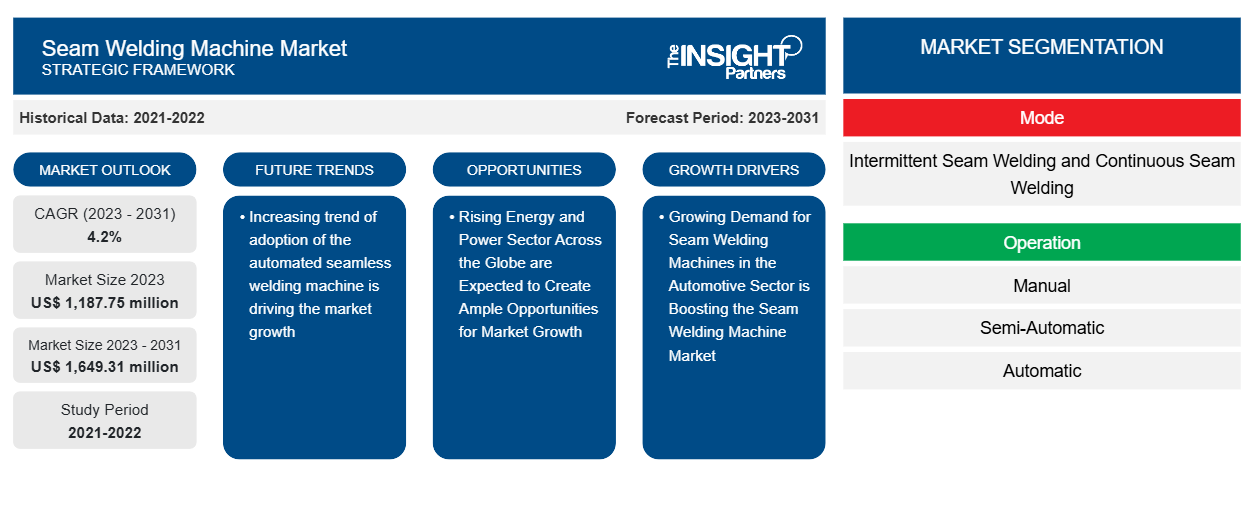缝焊机市场规模预计将从 2023 年的 11.8775 亿美元增至 2031 年的 16.4931 亿美元。预计 2023-2031 年市场复合年增长率为 4.2%。缝焊机由一个或两个电动轮组成,可在钢板部件上形成一系列重叠的点焊,以实现焊接部件的防气防液密封。无缝电流通过这些辊板,焊接部件被压在它们之间。汽车、工业制造、建筑能源和电力等不同行业对缝焊机的需求不断增长,推动了预测期内市场的增长。
缝焊机市场分析
缝焊机市场主要由亚太国家主导,例如印度、中国、韩国、日本等。这是由于亚太国家汽车制造厂的需求不断增长推动了市场增长。2023 年,印度汽车零部件制造进口额达到 203 亿美元,其中来自中国的份额高达 30%。印度政府正在推动国内电动汽车制造,推动缝焊机市场增长。
定制此报告以满足您的需求
您可以免费定制任何报告,包括本报告的部分内容、国家级分析、Excel 数据包,以及为初创企业和大学提供优惠和折扣
-
获取此报告的关键市场趋势。这个免费样品将包括数据分析,从市场趋势到估计和预测。
缝焊机市场概况
缝焊机市场驱动因素和机遇
汽车行业对缝焊机的需求不断增长,推动了缝焊机市场的发展
2022 年汽车产量较 2023 年增长 11.5%,全球汽车产量约为 9200 万辆。产量增长主要推动了领先汽车 OEM 对先进机器的需求,例如用于汽车面板制造的机器人焊接无缝焊接机。全球发达经济体汽车产量的快速增长推动了汽车行业缝焊机市场的增长。此外,随着混合动力电动汽车的出现,电动汽车产量不断上升,在缝焊机市场越来越受欢迎。
全球能源和电力行业的崛起预计将为市场增长创造充足的机会
能源和电力行业对太阳能电池板支架和工业锅炉制造的需求不断增加,预计将在预测期内为缝焊机市场增长创造充足的机会。例如,2024 年 1 月,Mortenson 和 Terra-Gen 在美国启动了最大的太阳能电池板和储能项目,名为 Edwards & Sanborn Solar。Mortenson 是该项目在美国的采购、工程和施工服务承包商。预计在预测期内,全球范围内此类项目的增加将为全球缝焊机市场增长创造充足的机会。Mortenson and Terra-Gen launched the largest solar panel and energy storage project named Edwards & Sanborn Solar in the US. Mortenson is the procurement, engineering, and construction service contractor for this project in the US. Increasing such projects across the globe is expected to create ample opportunity for the global seam welding machine market growth during the forecast period.
缝焊机市场报告细分分析
有助于得出缝焊机市场分析的关键部分是模式、操作和行业。
- 根据模式,市场分为间歇缝焊和连续缝焊。其中,由于全球汽车生产需求不断增长,连续缝焊占有最大份额。
- 根据操作,缝焊机市场分为手动、半自动和全自动。
- 根据行业,市场分为建筑、汽车、石油和天然气、制造业和其他。其中,汽车行业在 2023 年占有最大份额,这是由于全球汽车产量不断增加。
缝焊机市场份额按地区分析
缝焊机市场报告的地理范围主要分为五个区域:北美、亚太、欧洲、中东和非洲、南美/南美和中美。
根据地理位置,缝焊机市场主要分为北美、欧洲、亚太地区 (APAC)、中东和非洲 (MEA) 和南美 (SAM)。预计亚太地区将在 2023 年占据最大的市场份额,并且很可能在预测期内保持主导地位。此外,预计该地区的缝焊机市场在预测期内将出现最高的复合年增长率。这是由于中国、日本和印度等亚太国家的汽车产量增加。例如,2023 年,印度汽车制造商计划到 2028 年投资超过 70 亿美元,以加强其本地汽车零部件生产,如电动机、汽车面板、底盘等。此外,2024 年 3 月,Autoneum 计划扩大其在亚太国家(如中国和印度)的生产。该公司计划在印度西部的浦那和中国吉林长春开设两家新工厂。亚太国家对汽车领域的投资不断增加,为缝焊机市场的增长创造了巨大的需求。
预计到 2023 年,欧洲将占据缝焊机市场的第二大份额。相比之下,德国预计将成为区域缝焊机市场的主要贡献者。欧洲是顶级汽车制造商的所在地,包括梅赛德斯、大众、斯柯达、宝马和奥迪。根据经济、科学和生活质量政策部的数据,由于 2020 年 3 月至 5 月汽车工厂关闭,COVID-19 疫情间接影响了 110 多万个工作岗位。
此外,2020 年欧洲各地的汽车销量暴跌,而原始设备制造商 (OEM) 宣布进一步推迟重新开放装配厂。除了对乘用车和轻型商用车的需求下降之外,由于跨境流动限制导致原材料供应链中断,导致焊机等设备供应延迟。然而,COVID-19 疫情及其影响促使制造公司对其运营进行数字化和自动化,这使它们能够在 2020 年底恢复运营。制造公司的这种复苏努力为欧洲缝焊机供应商创造了未来的增长机会。
缝焊机市场区域洞察
Insight Partners 的分析师已详细解释了预测期内影响缝焊机市场的区域趋势和因素。本节还讨论了北美、欧洲、亚太地区、中东和非洲以及南美和中美洲的缝焊机市场细分和地理位置。

- 获取缝焊机市场的区域特定数据
缝焊机市场报告范围
| 报告属性 | 细节 |
|---|---|
| 2023 年的市场规模 | 11.8775亿美元 |
| 2031 年市场规模 | 16.4931亿美元 |
| 全球复合年增长率(2023 - 2031) | 4.2% |
| 史料 | 2021-2022 |
| 预测期 | 2023-2031 |
| 涵盖的领域 |
按模式
|
| 覆盖地区和国家 |
北美
|
| 市场领导者和主要公司简介 |
|
市场参与者密度:了解其对商业动态的影响
The Seam Welding Machine Market market is growing rapidly, driven by increasing end-user demand due to factors such as evolving consumer preferences, technological advancements, and greater awareness of the product's benefits. As demand rises, businesses are expanding their offerings, innovating to meet consumer needs, and capitalizing on emerging trends, which further fuels market growth.
Market players density refers to the distribution of firms or companies operating within a particular market or industry. It indicates how many competitors (market players) are present in a given market space relative to its size or total market value.
Major Companies operating in the Seam Welding Machine Market are:
- Emerson Electric Co.
- Dahching Electric Industrial
- FranzanKoike Aronson
- Inc.
- Leister Technologies
- CruxweldMiller
Disclaimer: The companies listed above are not ranked in any particular order.

- Get the Seam Welding Machine Market top key players overview
Seam Welding Machine Market News and Recent Developments
The Seam Welding Machine market is evaluated by gathering qualitative and quantitative data post primary and secondary research, which includes important corporate publications, association data, and databases. The following is a list of developments in the market for innovations, business expansion, and strategies:
- In 2022, Stealth, a global manufacturing expert in performance gear, launched a first-to-market, patented seam welding technology that removes the need for stitching. The technology results in warmer, tougher, and entirely durable seams for longer-lasting products that protect adventurers from the harshest elements. (Source: Eurofins, Press Release)
- In 2022, Miller Electric launched a single-wire automated Hercules high-deposition MIG welding system. The Hercules welding system enhances the welding capacity without additional cost requirements related to the welding cells. This is a seamless welding machine with high deposition rates and enhances productivity by up to 30%. (Source: SGS, Newsletter)
Seam Welding Machine Market Report Coverage and Deliverables
The “Seam Welding Machine Market Size and Forecast (2021–2031)” report provides a detailed analysis of the market covering the following areas:
- Seam Welding Machine Market size and forecast at global, regional, and country levels for all the key market segments covered under the scope
- Market dynamics such as drivers, restraints, and key opportunities
- Seam Welding Machine Market Trends
- Detailed PEST Analysis and SWOT analysis
- Seam Welding Machine Market Analysis covering key market trends, Global and regional framework, major players, regulations, and recent market developments.
- Seam Welding MachineMarket Industry landscape and competition analysis covering market concentration, heat map analysis, prominent players, and recent developments.
- Detailed Company Profiles
- Emerson Electric Co.
- Dahching Electric Industrial
- Franzan
- Koike Aronson, Inc.
- Leister Technologies
- Cruxweld
- Miller Weldmaster
- Schnelldorfer Maschinenbau
- 斯必罗国际
- 历史分析(2 年)、基准年、预测(7 年)及复合年增长率
- PEST和SWOT分析
- 市场规模、价值/数量 - 全球、区域、国家
- 行业和竞争格局
- Excel 数据集
近期报告
相关报告
客户评价
购买理由
- 明智的决策
- 了解市场动态
- 竞争分析
- 客户洞察
- 市场预测
- 风险规避
- 战略规划
- 投资论证
- 识别新兴市场
- 优化营销策略
- 提升运营效率
- 顺应监管趋势























 获取免费样品 - 缝焊机市场
获取免费样品 - 缝焊机市场